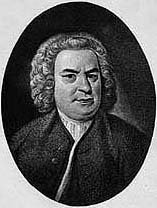The Critical Discographies from Choral Music On Records - Mass in B Minor Pages at the Teri Noel Towe Home Pages
Johann Sebastian Bach
The Critical Discographies from Choral Music On Records
This remarkable photograph is not a computer generated composite; the original of the Weydenhammer Portrait Fragment, all that
remains of the portrait of Johann Sebastian Bach that belonged to his pupil Johann Christian Kittel, is resting gently on the surface
of the original of the 1748 Elias Gottlob Haussmann Portrait of Johann Sebastian Bach.

1748 Elias Gottlob Haussmann Portrait, Courtesy of William H. Scheide, Princeton, New Jersey
Weydenhammer Portrait Fragment, ca. 1733, Artist Unknown, Courtesy of the Weydenhammer Descendants
Photograph by Teri Noel Towe
©Teri Noel Towe, 2001, All Rights Reserved
The Critical Discographies from Choral Music On Records
Mass in B Minor, BWV 232
Mass in B Minor, BWV 232
From Leipzig to Bethlehem
The Mass in B Minor is best thought of as an anthology, a collection of his "best" sacred music that Bach assembled in the last
years of his life. During the 1730s and 1740s, Bach put together several such kunstbücher (literally, books of art); the most widely
known are The Art of Fugue, the four volumes of the Clavier Übung, and the 17 Chorales of Different Kinds. Some of these
anthologies Bach either published or intended to publish; others, like the Mass, he did not. These less "commercial" distillations he
left to his heirs, physical and spiritual, to preserve and disseminate to those who were interested.
With the exception of the opening four measures of the first "Kyrie", it seems that every movement of the Mass is a reworking of an
existing vocal composition, either sacred or secular. At least one such movement, the "Crucifixus", dates to the Weimar years. The
"Kyrie" and "Gloria" were put together in 1733, as a presentation piece to the Elector of Saxony and King of Poland, from whom
Bach sought, ultimately successfully, the professionally and socially invaluable position of Court Composer. The "Sanctus" is a
careful and subtle revision of the setting of the text that he wrote for performance in Leipzig on Christmas Day, 1723. The
"Symbolum Nicenum" [the "Credo" section], and the concluding movements of the Mass were added in the late 1740s, when both
Bach's eyesight and his health were failing.
The "Kyrie", the "Gloria", and the "Symbolum Nicenum" are all in five voices; the texture expands to six voices in the "Sanctus"
and eight in the "Osanna". As Joshua Rifkin's controversial, but as yet unrefuted, findings have demonstrated convincingly, the
Mass in B Minor, like almost all of Bach concerted vocal music in fact, was meant to be sung by one singer to each line, even in
the "choruses". The principle is a simple one: Each performer got his own part, no matter how big or how small his rôle, and he
shared that part with no one else.
The complement of five "soloists" has caused numerous problems over the years. Who, for instance, sings the "Laudamus te",
which is assigned to the second soprano, in a performance for which only one soprano soloist has been engaged? The soprano or
the alto? Elly Ameling once remarked in a radio interview that it was the soloist who made the mistake of looking at the conductor
first when the aria came up at rehearsal. Many conductors, however, assign the two bass solos to different soloists, when Bach
calls only for one bass; the reason is simple: The "Quoniam" lies lower in the main than the "Et in spiritum sanctum". While
assembling the second half of the Mass some ten to fifteen years after he delivered the parts of the "Kyrie" and "Gloria" to the
Court in Dresden, Bach was not concerned about making the compass of the two arias comport comfortably with one another.
Although many, if not all, of the components could have been, and were, performed as parts of the various Leipzig church services
for which Bach provided the music, he gave no complete performance of the B Minor Mass, nor, apparently, did he ever intend to
put one on. It is, therefore, supremely ironic that this, Bach's own distillation of his "greatest" vocal music, apparently did not
receive its first complete performance until more than 100 years after his death.
There was, however, great interest in the work among the cognoscenti in the decades after Bach's death as well as in the years after
the onset of the general revival of interest in his music that was spawned by Mendelssohn-Bartholdy's seminal performance of the
St. Matthew Passion with the Berlin Singakademie in 1829. Carl Philipp Emanuel Bach put on a performance of the "Symbolum
Nicenum" in Hamburg in 1784, preceding it with a short instrumental introduction of his own composition. (For this performance,
as a guide to his copyists, Philipp Emanuel "touched up" the orchestration a bit on his father's autograph score, which also has
sustained some water damage, and his editorial changes went unnoticed until nearly ten years ago. As it happens, therefore, a copy
made by Philipp Emanuel's pupil, Schwenke, provides a more accurate text than the autograph itself.)
Haydn owned a copy of the Mass. Beethoven unsuccessfully sought to obtain one. Spontini put on a performance of the
"Symbolum Nicenum", through the "Et resurrexit", in Berlin in 1828, with 92 in the chorus, 56 strings, clarinets, horns, and
bassoons, but no trumpets or oboes. Under the direction of Carl Friedrich Rungenhagen, the Berlin Singakademie gave the "Kyrie"
and "Gloria" in 1834, and the balance of the work the following year. Portions of the Mass were performed at the Birmingham
Festival as early as 1837, and the Mass was among the works regularly performed by the London Bach Choir, which was founded
in 1876.
The first complete performance of the B Minor Mass in the United States was given in Bethlehem, Pennsylvania, by The Bach
Choir of Bethlehem, under the direction of its founder, Dr. J. Fred Wolle, in 1900. This first public presentation of the Mass in
America inaugurated an annual series of festival performances of the work that continues in Bethlehem to this day.
For three decades, from 1939 -- seven years after Dr. Wolle's death -- until 1969, The Bach Choir was directed by the distinguished
Welsh choral conductor, Ifor Jones. His forthright, Romantic reading of the score -- chockerblock full of rubatos and ritards -- was
recorded in 1960 [1]. Even though it is clearly his own interpretative handiwork, Jones's performance preserves many of the
interpretive traditions and conventions that had been established by Dr. Wolle in his 32 years at the helm of the Choir, traditions and
interpretative quirks that have been almost completely expunged, alas, in recent years. The first "Kyrie", for instance, is preceded by
a Moravian chorale. Intoned softly off stage by a brass choir, the hymn setting gives the pitch to the chorus, which comes in, forte,
on the chorale's final chord. Un-Bachian though it may be, the effect is undeniably overwhelming.
A very large but exceptionally well trained amateur chorus -- more than 175 singers -- is balanced against a smallish orchestra made
up largely of members of the Philadelphia Orchestra, including such distinguished instrumentalists as hornist Mason Jones and
oboist John DeLancie. The vocal soloists are average; only the golden trumpet of soprano Lois Marshall stands out. In better voice
than she was three years earlier when she sang the soprano part for Eugen Jochum, she is assigned the "Laudamus te" in addition to
the music normally given to the first soprano. This important documentation of the Bach Choir of Bethlehem's approach to the
Mass before it was diluted by a much more recent director's preference for "authenticity" rather than local tradition is also a
satisfying reading, one that will prove particularly appealing to those who like Bach played "with the heart on the sleeve" as the old
saying goes.
Please click here to advance to Page 2 - The Earliest Recordings.
Please click here to visit the Endnotes Page.
Please click here to visit the Alphabetical Discography Page.
Please click here to return to the Critical Discographies from Choral Music On Records Main Page.
Please click on  to return to the Johann Sebastian Bach Index Page.
to return to the Johann Sebastian Bach Index Page.
Please click on the  to return to the Teri Noel Towe Welcome Page.
to return to the Teri Noel Towe Welcome Page.
teritowe@alumni.Princeton.EDU
Copyright, Teri Noel Towe, 1989, 1997, 2001
All Rights Reserved
The The Critical Discographies from Choral Music On Records - Mass in B Minor Pages at the Teri Noel Towe Home Pages
are PPP Free web pages.

The The Critical Discographies from Choral Music On Records - Mass in B Minor Pages at the Teri Noel Towe Home Pages
have received the HIP Woolly Mammoth Stamp of Approval from The HIP-ocrisy Home Page.